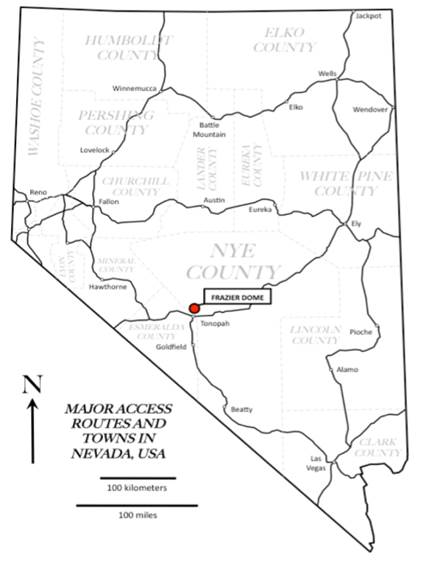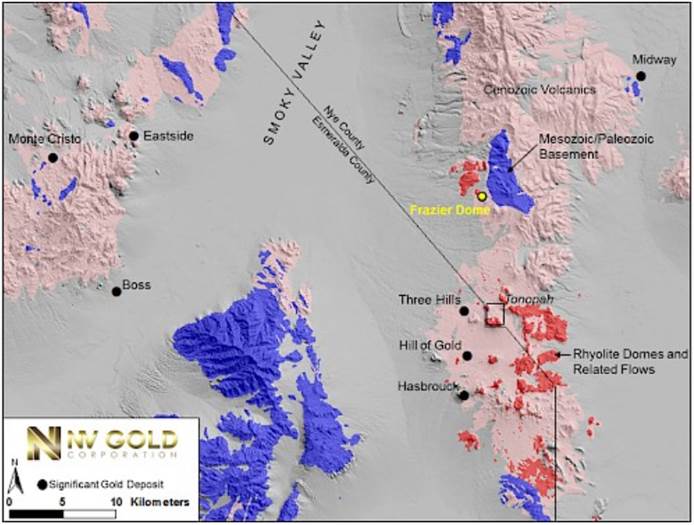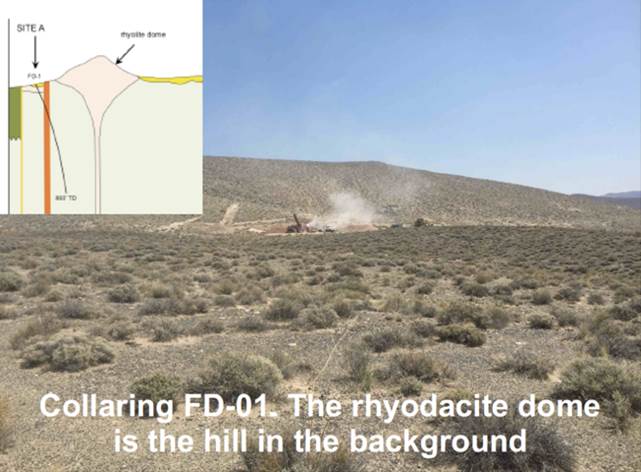NV Gold chasing high-grade Au in Nevada
- Home
- Articles
- Uncategorized
- NV Gold chasing high-grade Au in Nevada

2019.04.09
NV Gold (TSX-V:NVX, US-NVGLF) has big plans for 2019 having just doubled the claims on its flagship Frazier Dome Gold Project in the famed Tonopah Gold District of Nevada.

On Tuesday, NV Gold released its summer exploration agenda, in conjunction with announcing it has staked an additional 71 claims, thereby doubling its land position at the Frazier Dome Gold Project to 143 claims.
NV Gold has been evaluating the 1,195-hectare property since it completed a relatively small drill program in the second half of 2018, which potentially may have identified the possibility of a mineralized gold system at depth – something relatively unusual for Nevada, which has built a gold-mining reputation on a foundation of low-grade, but high-tonnage mines, where disseminated (microscopic) gold is mined close to surface and heap-leached at reasonably low cost.
President and COO Peter Ball indicated management has been taking a closer look at the project since an initial evaluation last year and the 8-hole drill program:
“We looked at the overall model that is presented at Frazier Dome and compared it first to other local rhyolite dome fields that have yielded gold in the Tonapah Mining District. It became evident that we may be onto something that exists at depth beneath our last drill holes. Our technical team completed an internal model, reviewed the identified high grade mineralization at surface, studied the exposed fractured vein sets, and finally we were excited about the abundant alteration scattered around Frazier. This all led to strategically adding key claims to ensure we captured the areas to the northwest and southeast,” Ball told Ahead of the Herd by phone, Tuesday morning, at the same time as geologists were arriving at the property with boots on the ground. “The 2018 small drill program identified some of the longest runs of anomalous gold mineralization we’ve seen in any drill program, from surface down to 500+ feet.”
3 high-grade zones
Frazier Dome is about 13 km north of the Tonopah Gold District – which historically produced 174 million ounces of silver and 1.9 million ounces of gold – on the border of Nye County and Esmeralda County.
The project is a low-sulfidation, volcanic-hosted epithermal gold system with high-grade mineralization in three settings, explained in detail below.
Drilling between 1980 and 1991 intersected significant gold mineralization, but it was shallow – under 150m, and never followed up on. Not all the outcroppings or mineralized areas under ground cover were tested. NV Gold’s primary target is the gold mineralization adjacent to and at depth to an intrusive rhyolite dome, especially at the basement contact, known to be a setting conducive to the development of high-grade epithermal mineralization elsewhere in Nevada.
That gives a decent picture, to the trained eye, but let’s unpack this information.
First, what is epithermal gold? A clue is in the name. In Greek “epi” means shallow and “thermal” refers of course to heat, in this case, heated fluid necessary for the deposit’s formation. Millions of years ago, volcanic activity deep in the Earth’s crust thrust boiling hot liquid to surface, containing minerals like gold and silver that precipitated into cracks in the rock. Epithermal veins can stretch hundreds of meters deep and are usually narrow and high-grade. In conjunction with these veins, are large alteration “haloes” of mineralization made by circulating hydrothermal fluids.
While usually high-grade and close to surface, epithermal gold deposits are generally low tonnage, unlike Nevada’s three northwest trending belts: the Carlin, Cortez and Walker Lane trends, which are three of the world’s top mining districts.
Epithermal deposits are divided into low-sulfidation and high-sulfidation. Low sulfide deposits are formed when groundwater comes into contact with molten rock deep underneath volcanoes. The water dissolves silicate minerals along with gold, silver, arsenic, cadmium, lead, zinc, antimony and mercury. As the super-heated groundwater moves up towards surface, the minerals are deposited in cracks and faults in the rock, mainly within quartz. High-sulfide epithermal deposits are richer in sulfide minerals like pyrite, enargite, gold and silver. They are often linked to porphyry copper-gold deposits.
Frazier Dome is characterized as “a low- to intermediate-sulfidation, volcanic-hosted epithermal gold system with high-grade mineralization.”
That’s in line with two types of mineralization often seen around Tonopah:
- High-grade, intermediate-sulfidation silver-rich veins and
- Younger, low-sulfidation, gold-rich mineralization related to intrusive rhyolite domes, which have been the focus of West Kirkland Mining’s Hasbrouck, Hill of Gold and Three Hills mines to the south (total combined production of 1,063,000 ounces gold and 16,345,000 oz silver; and Allegiant Gold’s Eastside project 32 km to the west, which has shored up an inferred resource estimate of 654,000 ounces gold and 3.9 million ounces silver.
A rhyolite dome is a mound of rock containing rhyolite, a type of igneous rock formed when lava exudes from a volcano, creating a dome-like structure around the vent. The presence of a rhyolite dome at Frazier Dome is significant, because all of the other domes (cited above) around it have unearthed significant gold mineralization. Frazier is one of the last unexplored rhyolite domes in Tonopah.

To NV Gold, Frazier Dome became an immediate focus based on reported widespread alteration and gold-silver mineralization across the property, with high-grade (10 g/t) or greater gold values found in three separate settings.
One of the high-grade areas is associated with quartz-filled fractures at the surface, with samples from a collapsed adit (entrance to an underground mine) running as high as 11.25 g/t gold.
The second high-grade zone occurs a few hundred meters to the north as an historic drilling intercept, at the contact between overlying volcanic rocks and basement rocks, with 3 meters of 7.5 g/t gold, including 1.5m of 10.39 g/t gold.

Hematitic silicified breccia adjacent to rhyolite dome
NV Gold 3m channel sample JM-FW8 (6.1 g/t Au, 22 g/t Ag over 3 m)
The third high-grade area is associated with a shaft and decline, referred to as the Dalton shaft in earlier historical reports. The partially collapsed shaft is shallow at around 6m deep and is associated with silicified breccia stockpiles at the surface, and a thin (2.5-cm wide) quartz vein that contained masses of visible gold up to an estimated 0.75 ounces (23.3 grams) in individual samples. Work here dates back to at least the 1970s, with samples containing as much as 14.7g/t gold.
The question for Peter Ball and NV Gold’s geologists is, what is the relationship between the high-grade, gold-silver anomalies found throughout the property, and the rhyolite dome that started off as a sort of slurry pipe, carrying mineralized fluids through the volcano to surface, where the lava cooled to form a dome-like protrusion? The answer is tantalizing.

“Evidence so far leads us to belive that we may be sitting on top of a higher grade system at depth. Not often do you drill a hole from surface to 500 ft+, and nearly every 5ft section carries anomalous gold. We may be a few feet above something very interesting, and we plan on going deeper this summer,” says Ball, noting the many vein sets and quartz-filled fracture systems showing up amid the widespread alteration across the property give a clue as to what lies beneath. “It is always a good sign to have multiple high grade samples such as seven and a half-grammers ,10-grammers, and 14-grammers all sitting in and around this dome, and these domes [in the Tonopah district] have delivered a lot of gold.”
2018 drilling
To gather more information about the project, a short 8-hole drill program (1,408m) was set up for three weeks in the fall of 2018. Nine targets were identified.
All 8 holes encountered long runs of altered and mineralized rock, with “the most intense alteration associated with silica and pyrite in breccia zones”. The strongest intervals were 12.2 meters 0.53 g/t in Hole FD-8, and 7.6m of 0.38 g/t in Hole FD-1.
Despite relatively low grades ranging from 0.005 to 0.020 g/t gold, assaying long continual runs of detectable gold occurred in FD-1 (~105 meters), FD-2 (~150 meters), and FD-5 (135 meters) is an excellent sign.
Ball explained that the plan was to drill an at angle under the rhyolite dome, aiming for what NV Gold thought was the feeder zone that transported fluids through the volcano, but “the drill hole deviated to near vertical, thereby missing the feeder zone”. This summer, a drill crew will follow up that hole.
The most interesting thing about the 2018 drill program though, which left five target areas left to test, is the possibility of “an interpreted model of a potential robust gold system at depth”. A strong indication is that 5 of the 9 widely-spaced holes delivered gold intersections greater than 0.10 g/t, and up to 1.035 g/t. In three of the holes, anomalous gold was found in every 1.5m section, all the way from surface to the bottom of the hole, to a depth of 150m.
“Our model is leading us to believe there may be a potential a high-grade system sitting at the base of the volcano, sub-150 meters, that developed into this halo of anomalous gold above. In laymans terms, the anomalous gold made it its way through the fractures all the way up from below where our holes eneded in 2018,” Ball told Ahead of the Herd.
VP Exploration Marcus Johnston remarked on how the similarities between the Frazier rhyolite dome, to the rhyolite domes at the Eastside, Hasbrouck and Three Hills gold deposits, make the project highly prospective:
“The 8 reverse- circulation holes NVX drilled in 2018 all encountered significant runs of alteration and gold and silver mineralization. The lengths and widths of the mapped fracture/vein sets, combined with the long-runs of alteration and mineralization in drilling, and the shallow nature of the exposed system all point toward a potentially bonanza-grade deeper deposit(s), and the possibility of bulk-tonnage ore to be found on the property.”
Note: Dr. Marcus Johnston recently joined NV Gold, after 25+ years working in Nevada for such companies as Newmont Gold, Renaissance Gold and Victoria Gold, and has evaluated more than 500 projects across the state.
2019 exploration plans
Simply put, NV Gold plans to go deep. The Company will set up reverse-circulation drills and test the four targets it drilled last year, to a depth greater than 150 meters. The idea is to try and find the source of the high-grade mineralization at surface. Here’s Peter Ball:
“There’s just too big of an alteration field, combined with multiple high grade samples sitting at surface that had to come from somewhere. We’re chasing high-grade mineralization not low-grade, and even though 0.4 to 0.6 g/t in Nevada is excellent, we’re looking for these 10+ grammers sitting beneath, which we test this summer to see what is beneath and feeding this intense alteration across Frazier.”
Before the drills start turning, however, Ball and his team want to glean more information about known targets and to identify new targets buried elsewhere on the property. This will include mapping, a sampling program and structural analysis, combined with a geophysical program comprising gravity and magnetic surveys.
Ball commented, “We are excited, and to ensure we get things rolling, Dr. Odin Christensen and Dr. Marcus Johnston arrived on site this morning (April 2, 2019).”
Drilling is planned for late June or July.
Conclusion
Junior gold investors sometimes overlook Nevada, thinking that all the precious metal has been found. While the western state certainly has been well-explored and mined, there are pockets of undeveloped ground. NV Gold’s Frazier Dome project is an example of a gold mineralized area that has yet to be tapped.
The property has closeology in its favor, with a number of rhyolite domes around it that have been successfully mined or wrapped into resource estimates. Location is also key, being within an established mining district with infrastructure – power, water and a work force – close by. And as detailed in our last article on NV Gold; a) NV Gold’s management team is superb and Nevada Veterans (Dr. Quinton Hennigh, Dr. Odin Christense, Dr. Marcus Johnston, John Watson M.Sc.), with 125 years of combined experience in Nevada, and b) They have an incredible data set to help guide their claim staking and exploration efforts.
For all of these reasons I have NVX on my radar screen.
Richard (Rick) Mills
Ahead of the Herd Twitter
Ahead of the Herd FaceBook
Legal Notice / Disclaimer
This document is not and should not be construed as an offer to sell or the solicitation of an offer to purchase or subscribe for any investment. Richard Mills has based this document on information obtained from sources he believes to be reliable but which has not been independently verified. Richard Mills makes no guarantee, representation or warranty and accepts no responsibility or liability as
to its accuracy or completeness. Expressions of opinion are those of Richard Mills only and are subject to change without notice. Richard Mills assumes no warranty, liability or guarantee for the current relevance, correctness or completeness of any information provided within this Report and will not be held liable for the consequence of reliance upon any opinion or statement contained herein or any omission. Furthermore, I, Richard Mills, assume no liability for any direct or indirect loss or damage or, in particular, for lost profit, which you may incur as a result of the use and existence of the information provided within this Report.
NV Gold Corp (TSX.V:NVX), is an advertiser on Richard’s site aheadoftheherd.com. Richard owns shares of NVX
Legal Notice / Disclaimer
Ahead of the Herd newsletter, aheadoftheherd.com, hereafter known as AOTH.Please read the entire Disclaimer carefully before you use this website or read the newsletter. If you do not agree to all the AOTH/Richard Mills Disclaimer, do not access/read this website/newsletter/article, or any of its pages. By reading/using this AOTH/Richard Mills website/newsletter/article, and whether you actually read this Disclaimer, you are deemed to have accepted it.

























